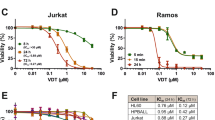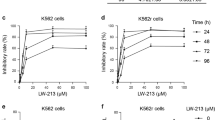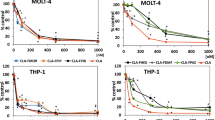Abstract
We have studied the in vitro actions of the sesquiterpene lactone parthenolide (PTL) on cells isolated from patients with chronic lymphocytic leukemia (CLL). Dye reduction viability assays showed that the median LD50 for PTL was 6.2 μ M (n=78). Fifteen of these isolates were relatively resistant to the conventional agent chlorambucil but retained sensitivity to PTL. Brief exposures to PTL (1–3 h) were sufficient to induce caspase activation and commitment to cell death. Chronic lymphocytic leukemia cells were more sensitive towards PTL than were normal T lymphocytes or CD34+ haematopoietic progenitor cells. The mechanism of cell killing was via PTL-induced generation of reactive oxygen species, resulting in turn in a proapoptotic Bax conformational change, release of mitochondrial cytochrome c and caspase activation. Parthenolide also decreased nuclear levels of the antiapoptotic transcription factor nuclear factor-kappa B and diminished phosphorylation of its negative regulator IκB. Killing of CLL cells by PTL was apparently independent of p53 induction. This is the first report showing the relative selectivity of PTL towards CLL cells. The data here warrant further investigation of this class of natural product as potential therapeutic agents for CLL.
This is a preview of subscription content, access via your institution
Access options
Subscribe to this journal
Receive 12 print issues and online access
$259.00 per year
only $21.58 per issue
Buy this article
- Purchase on Springer Link
- Instant access to full article PDF
Prices may be subject to local taxes which are calculated during checkout







Similar content being viewed by others
References
Chiorazzi N, Rai KR, Ferrarini M . Chronic lymphocytic leukemia. N Engl J Med 2005; 352: 804–815.
Keating MJ, O'Brien S, Lerner S, Koller C, Beran M, Robertson LE et al. Long-term follow up of patients with chronic lymphocytic leukemia (CLL) receiving fludarabine regimes as initial therapy. Blood 1998; 92: 1165–1171.
Rai KR, Peterson BL, Appelbaum FR, Kolitz J, Elias L, Shepherd L et al. Fludarabine compared with chlorambucil as primary therapy for chronic lymphocytic leukemia. N Engl J Med 2000; 343: 1750–1757.
Anaissie EJ, Kontoyiannis DP, O'Brien S, Kantarjian H, Robertson L, Lerner S et al. Infection in patients with chronic lymphocytic leukemia treated with fludarabine. Ann Intern Med 1998; 129: 559–566.
Rosenwald A, Chuang EY, Davis RE, Wiestner A, Alizadeh AA, Arthur DC et al. Fludarabine treatment of patients with chronic lymphocytic leukemia induces a p53-dependent gene expression response. Blood 2004; 104: 1428–1434.
Pettitt AR, Sherrington PD, Stewart G, Cawley JC, Taylor AM, Stankovic T . p53 dysfunction in B-cell chronic lymphocytic leukemia: inactivation of ATM as an alternative to TP53 mutation. Blood 2001; 98: 814–822.
Lin K, Sherrington PD, Dennis M, Matrai Z, Cawley JC, Pettitt AR . Relationship between p53 dysfunction, CD38 expression and IgVH mutation in chronic lymphocytic leukemia. Blood 2002; 100: 1404–1409.
Shanafelt TD, Geyer SM, Kay NE . Prognosis at diagnosis: integrating molecular biologic insights into clinical practice for patients with CLL. Blood 2004; 103: 1202–1210.
Pepper CJ, Hambly RM, Fegan CD, Delavault P, Thurston DE . The novel sequence-specific DNA cross-linking agent SJG-136 (NSC 694501) has potent and selective in vitro cytotoxicity in human B-cell chronic lymphocytic leukemia cells with evidence of a p53-independent mechanism of cell kill. Cancer Res 2004; 64: 6750–6755.
Shanafelt TD, Lee YK, Bone ND, Strege AK, Jelinek DF, Kay NE et al. Adaphostin-induced apoptosis in CLL B cells is associated with induction of oxidative stress and exhibits synergy with fludarabine. Blood 2005; 105: 2099–2106.
Campas C, Lopez JM, Santidrian AF, Barragan M, Bellosillo B, Colomer D et al. Acadesine activates AMPK and induces apoptosis in B-cell chronic lymphocytic leukemia cells but not in T lymphocytes. Blood 2003; 101: 3674–3680.
Duechler M, Shehata M, Schwarzmeier JD, Hoelbl A, Hilgarth M, Hubmann R . Induction of apoptosis by proteasome inhibitors in B-CLL cells is associated with downregulation of CD23 and inactivation of Notch2. Leukemia 2005; 19: 260–267.
Lee YK, Bone ND, Strege AK, Shanafelt TD, Jelinek DF, Kay NE . VEGF receptor phosphorylation status and apoptosis is modulated by a green tea component, epigallocatechin-3-gallate (EGCG), in B-cell chronic lymphocytic leukemia. Blood 2004; 104: 788–794.
Campas C, Dalmau M, Montaner B, Barragan M, Bellosillo B, Colomer D et al. Prodigiosin induces apoptosis of B and T cells from B-cell chronic lymphocytic leukemia. Leukemia 2003; 17: 746–750.
Knight DW . Feverfew: chemistry and biological activity. Nat Prod Rep 1995; 12: 271–276.
Wen J, You KR, Lee SY, Song CH, Kim DG . Oxidative stress-mediated apoptosis. The anticancer effect of the sesquiterpene lactone parthenolide. J Biol Chem 2002; 277: 38954–38964.
Park JH, Liu L, Kim IH, Kim JH, You KR, Kim DG . Identification of the genes involved in enhanced fenretinide-induced apoptosis by parthenolide in human hepatoma cells. Cancer Res 2005; 65: 2804–2814.
Kim JH, Liu L, Lee SO, Kim YT, You KR, Kim DG . Susceptibility of cholangiocarcinoma cells to parthenolide-induced apoptosis. Cancer Res 2005; 65: 6312–6320.
Guzman ML, Rossi RM, Karnischky L, Li X, Peterson DR, Howard DS et al. The sesquiterpene lactone parthenolide induces apoptosis of human acute myelogenous leukemia stem and progenitor cells. Blood 2005; 105: 4163–4169.
Kwok BH, Koh B, Ndubuisi MI, Elofsson M, Crews CM . The anti-inflammatory natural product parthenolide from the medicinal herb feverfew directly binds to and inhibits IκB kinase. Chem Biol 2001; 8: 759–766.
Jones DT, Addison E, North JM, Lowdell MW, Hoffbrand AV, Mehta AB et al. Geldanamycin and herbimycin A induce apoptotic killing of chronic lymphocytic leukemia cells and augment the cells' response to cytotoxic drugs. Blood 2004; 103: 1855–1861.
Wuchter C, Krappmann D, Cai Z, Ruppert V, Scheidereit C, Dorken B et al. In vitro susceptibility to TRAIL-induced apoptosis of acute leukemia cells in the context of TRAIL receptor gene expression and constitutive NF-κB activity. Leukemia 2001; 15: 921–928.
Posovszky C, Friesen C, Herr I, Debatin KM . Chemotherapeutic drugs sensitize pre-B ALL cells for CD95- and cytotoxic T lymphocyte-mediated apoptosis. Leukemia 1999; 13: 400–409.
Ramsby ML, Makowski GS . Differential detergent fractionation of eukaryotic cells. Analysis by two-dimensional gel electrophoresis. Methods Mol Biol 1999; 112: 53–66.
Liu FT, Newland AC, Jia L . Bax conformational change is a crucial step for PUMA-mediated apoptosis in human leukemia. Biochem Biophys Res Commun 2003; 310: 956–962.
Cory S, Adams JM . The Bcl2 family: regulators of the cellular life-or-death switch. Nat Rev Cancer 2002; 2: 647–656.
Bellosillo B, Villamor N, Lopez-Guillermo A, Marce S, Bosch F, Campo E et al. Spontaneous and drug-induced apoptosis is mediated by conformational changes of Bax and Bak in B-cell chronic lymphocytic leukemia. Blood 2002; 100: 1810–1816.
Stilgenbauer S, Bullinger L, Lichter P, Dohner H, German CLL Study Group (GCLLSG). Chronic lymphocytic leukemia. Genetics of chronic lymphocytic leukemia: genomic aberrations and VH gene mutation status in pathogenesis and clinical course. Leukemia 2002; 16: 993–1007.
Komarov PG, Komarova EA, Kondratov RV, Kristov-Tselkov K, Coon JS, Chernov MV et al. A chemical inhibitor of p53 that protects mice from the side effects of cancer therapy. Science 1999; 285: 1733–1737.
Acknowledgements
This work was supported by the Leukemia Research Fund, UK.
Author information
Authors and Affiliations
Corresponding author
Additional information
Supplementary Information accompanies the paper on the Leukemia website (http://www.nature.com/leu)
Rights and permissions
About this article
Cite this article
Steele, A., Jones, D., Ganeshaguru, K. et al. The sesquiterpene lactone parthenolide induces selective apoptosis of B-chronic lymphocytic leukemia cells in vitro. Leukemia 20, 1073–1079 (2006). https://doi.org/10.1038/sj.leu.2404230
Received:
Revised:
Accepted:
Published:
Issue Date:
DOI: https://doi.org/10.1038/sj.leu.2404230
Keywords
This article is cited by
-
Antitumor effects of the small molecule DMAMCL in neuroblastoma via suppressing aerobic glycolysis and targeting PFKL
Cancer Cell International (2021)
-
The role of oxidative stress in anticancer activity of sesquiterpene lactones
Naunyn-Schmiedeberg's Archives of Pharmacology (2015)
-
Antimyeloma activity of the sesquiterpene lactone cnicin: impact on Pim-2 kinase as a novel therapeutic target
Journal of Molecular Medicine (2012)
-
Parthenolide, a Sesquiterpene Lactone, Expresses Multiple Anti-cancer and Anti-inflammatory Activities
Inflammation (2012)
-
p53 and Notch signaling in chronic lymphocytic leukemia: clues to identifying novel therapeutic strategies
Leukemia (2011)



